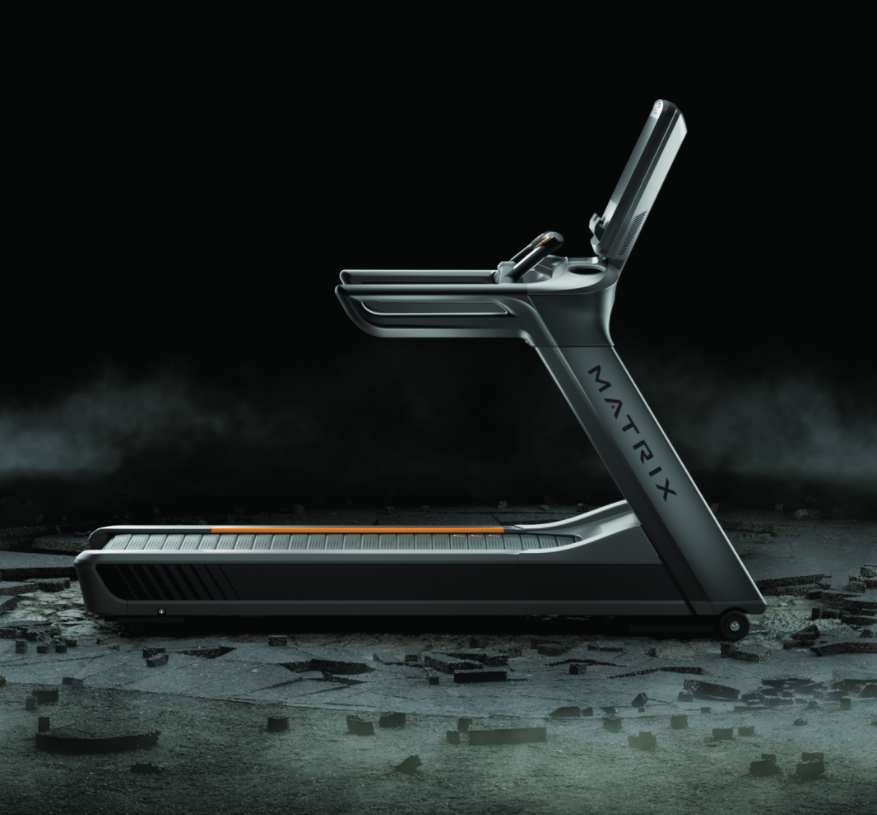
Performance Plus Treadmill White Paper
Quantifying Comfort: The Matrix Performance Plus Treadmill
When we first began designing the Performance Plus, our goal was to offer a premium run-feel that was comfortable during even the longest and most intense workouts. While traditional treadmills feature a polymer belt and deck mounted to a frame with cushioning elastomers, our new slat-belt design included individually mounted aluminium t-slats with an impact-absorbing rubber coating. Early feedback from our test subjects suggested that the slat-belt design did indeed provide a better run-feel than a traditional belt and deck. However, could we scientifically quantify the added comfort and prove that this design was in fact beneficial for the body of a runner in a measurable way? We posed that question to the experts of our in-house biomechanics lab, and they began their investigation.
Understanding the Physiological Impacts of Running
To start, we first had to take a close look at how the body reacts to each step when running. We knew that no matter what the speed, the bones in the lower body are compressed with each foot strike, distributing the impact through the body. We also knew that repeated foot strikes, especially when the runner is fatigued, can create a risk of stress fractures and other overuse injuries.1 Furthermore, we had to take into consideration that each runner’s unique foot strike pattern can make a significant difference in the kind of overuse injuries a runner might incur. Those with a heel strike pattern, the most common pattern among distance runners, are more likely to develop plantar fasciitis, which involves inflammation of the ligament connecting the heel to the forefoot. Mid-foot strike patterns, on the other hand, absorb impact in the ankle and calf
muscle, which can increase the overall stress on the runner’s body. Finally, runners with a forefoot strike pattern tend to overuse their calf muscles, and this can cause injuries to the Figure 1. Motion Capture and Running Gait Analysis tibia, patella tendon and knee.

Figure 1. Motion Capture and Running Gait Analysis
Gathering Participants
Understanding the subtleties of how different foot strike patterns effect runners was crucial when gathering participants for our study. In this endeavour, our biomechanics lab cast a wide net. They enlisted subjects who had a variety of running experience, ranging from those with no recreational running experience at all to subjects who had trained for full marathons. All participants wore their own running shoes, which included everything from lightly to heavily cushioned designs. Additionally, none of them had incurred any significant lower leg injuries in the past six months. Perhaps most importantly, our participants exhibited a full spectrum of foot strike patterns, from heel to mid-foot to forefoot, so we could be sure that our results were sound and valid no matter how a user naturally moved.
Studying the Experience
We first compared over-ground training to running on a traditional treadmill to measure the difference in impact on the lower body. We then measured the difference in impact between the Performance Plus Treadmill and a traditional treadmill. To obtain precise measurements, participants were fitted with accelerometer sensors to their lower body and lower back. Paired with motion capture technology, these sensors would measure the amount of impact distributed through the runner’s body with each step. After warming up, participants were asked to walk at 3.5 mph, run at 6 mph and jog at a speed that would be comfortable for a distance run. During each interval, both the data from the sensors and the video from the motion capture were evaluated. To double-check our work, we conducted a running gait study to compare running gait on a traditional treadmill against the Performance Plus to ensure that any reduction in impact wasn’t actually a transfer of impact to a different part of the body due to a change in running gait. No change was found, which indicated that any measurable reductions in impact were direct effects of our slat-belt design.

Figure 2. Test Subject Sensor Placement
Verifying the Benefits
In the end, the results of our study showed that the Performance Plus Treadmill provided even greater benefits to runners than we expected. At 3.5 mph, a traditional treadmill reduced impact by 30% when compared to overground training, so it was still a great training tool for walkers and runners alike. At the same speed, the Performance Plus Treadmill reduced impact by 17% when compared to a traditional treadmill. As speed increased, these benefits also became more significant. At 6 mph, the Performance Plus reduced impact by 19% when compared to a traditional treadmill. This suggests that while the slat-belt design of our Performance Plus can help prevent overuse injuries for anyone who sets foot on it, the impact-reducing benefits are even more pronounced for the world’s most intense and committed running enthusiasts.
References
1. J. Mizrahi, O. Verbitsky, E. Isakov, and D. Daily, “Effect of fatigue on leg kinematics and impact acceleration in long distance running, ” Human Movement Science, vol. 19, no. 2, pp. 139–151, 2000.
2. “Regency Clinic,” Chiropractic, Physiotherapy, Sport Massage, Rehabilitation, 04-Jan-2018. [Online]. Available: https://www.regency-clinic.co.uk/running-actually-happens/.

0 comment